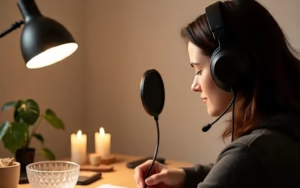Tips for Making ASMR Videos That Truly Soothe Your Audience
ASMR, or Autonomous Sensory Meridian Response, has taken the internet by storm over the last decade. Millions of viewers flock to YouTube, TikTok, and other platforms in search of soothing sounds and relaxing visuals to help them unwind, sleep, or reduce anxiety. Whether you’re just starting out or looking to improve your content, there are several key tips for making ASMR videos that resonate with your audience and stand out in a growing niche.
Choose the Right Equipment
The foundation of any great ASMR video lies in high-quality audio. Investing in a good microphone is crucial. Binaural microphones, such as the 3Dio Free Space or the Blue Yeti, are especially popular in the ASMR community because they capture sound in a way that mimics human hearing, creating an immersive experience.
Additionally, make sure your recording environment is quiet. Background noise can ruin the relaxing atmosphere, so soundproof your space as much as possible and record during quiet hours.
Plan Your Triggers
ASMR is all about “triggers”—sounds or visuals that provoke the tingling sensation associated with ASMR. Popular triggers include whispering, tapping, brushing, crinkling, and roleplay scenarios. Before recording, decide which triggers you want to focus on and practice them to ensure they sound natural and soothing.
Don’t be afraid to experiment. What works for one audience might not work for another, so try different triggers and pay attention to feedback.
Focus on Audio Quality Over Visuals
While visual elements can enhance your video, audio is the star of the show. Make sure you’re recording in high resolution (at least 44.1 kHz) and consider using software like Audacity or Adobe Audition to clean up your audio. Eliminate background noise, balance volume levels, and add subtle effects if needed to enhance the relaxation factor.
Use a Calm and Relaxing Tone
Whether you’re whispering, softly speaking, or roleplaying, your tone should be calm, slow, and deliberate. Fast talking or sudden volume changes can be jarring and break the immersion. If you’re doing a roleplay (like a spa visit or doctor check-up), script your dialogue to maintain a consistent flow and avoid awkward pauses.
Create a Comfortable Setting
The visual aspect of ASMR should complement the sounds. Use soft lighting, neutral colors, and simple backgrounds to create a calming atmosphere. Avoid overly bright lights or cluttered environments that could distract viewers. Many successful ASMRtists use a cozy setup with candles, blankets, and soothing props to reinforce the relaxing vibe.
Engage with Your Audience
Community is a huge part of ASMR. Read comments, ask for suggestions, and consider making custom videos based on viewer requests. Responding to feedback shows that you care and helps build a loyal audience. Many creators grow their channels by regularly interacting with fans and improving based on what they enjoy most.
Be Consistent and Patient
Like any content niche, growth takes time. Upload consistently, even if it’s once a week. Over time, your editing, mic skills, and performance will improve. Keep track of your most popular videos and try to understand what made them successful—then double down on those elements in future content.




